+ Open data
Open data
- Basic information
Basic information
| Entry | Database: EMDB / ID: EMD-2753 | |||||||||
|---|---|---|---|---|---|---|---|---|---|---|
| Title | PGT124 in complex with BG505 SOSIP.664 Env trimer | |||||||||
 Map data Map data | Reconstruction of PGT124 Fab in complex with BG505 SOSIP.664 Env trimer | |||||||||
 Sample Sample |
| |||||||||
 Keywords Keywords | PGT124 / HIV-1 / envelope glycoprotein trimer / SOSIP / broadly neutralizing antibody | |||||||||
| Biological species |  Homo sapiens (human) Homo sapiens (human) | |||||||||
| Method | single particle reconstruction / negative staining / Resolution: 17.8 Å | |||||||||
 Authors Authors | Garces F / Sok D / Kong L / McBride R / Kim HJ / Saye-Francisco KF / Julien J-P / Hua Y / Cupo A / Moore JP ...Garces F / Sok D / Kong L / McBride R / Kim HJ / Saye-Francisco KF / Julien J-P / Hua Y / Cupo A / Moore JP / Ward AB / Paulson JC / Burton DR / Wilson IA | |||||||||
 Citation Citation |  Journal: Cell / Year: 2014 Journal: Cell / Year: 2014Title: Structural evolution of glycan recognition by a family of potent HIV antibodies. Authors: Fernando Garces / Devin Sok / Leopold Kong / Ryan McBride / Helen J Kim / Karen F Saye-Francisco / Jean-Philippe Julien / Yuanzi Hua / Albert Cupo / John P Moore / James C Paulson / Andrew B ...Authors: Fernando Garces / Devin Sok / Leopold Kong / Ryan McBride / Helen J Kim / Karen F Saye-Francisco / Jean-Philippe Julien / Yuanzi Hua / Albert Cupo / John P Moore / James C Paulson / Andrew B Ward / Dennis R Burton / Ian A Wilson /  Abstract: The HIV envelope glycoprotein (Env) is densely covered with self-glycans that should help shield it from recognition by the human immune system. Here, we examine how a particularly potent family of ...The HIV envelope glycoprotein (Env) is densely covered with self-glycans that should help shield it from recognition by the human immune system. Here, we examine how a particularly potent family of broadly neutralizing antibodies (Abs) has evolved common and distinct structural features to counter the glycan shield and interact with both glycan and protein components of HIV Env. The inferred germline antibody already harbors potential binding pockets for a glycan and a short protein segment. Affinity maturation then leads to divergent evolutionary branches that either focus on a single glycan and protein segment (e.g., Ab PGT124) or engage multiple glycans (e.g., Abs PGT121-123). Furthermore, other surrounding glycans are avoided by selecting an appropriate initial antibody shape that prevents steric hindrance. Such molecular recognition lessons are important for engineering proteins that can recognize or accommodate glycans. | |||||||||
| History |
|
- Structure visualization
Structure visualization
| Movie |
 Movie viewer Movie viewer |
|---|---|
| Structure viewer | EM map:  SurfView SurfView Molmil Molmil Jmol/JSmol Jmol/JSmol |
| Supplemental images |
- Downloads & links
Downloads & links
-EMDB archive
| Map data |  emd_2753.map.gz emd_2753.map.gz | 11 MB |  EMDB map data format EMDB map data format | |
|---|---|---|---|---|
| Header (meta data) |  emd-2753-v30.xml emd-2753-v30.xml emd-2753.xml emd-2753.xml | 10.9 KB 10.9 KB | Display Display |  EMDB header EMDB header |
| Images |  EMD-2753-PGT124_EM_snapshot2.png EMD-2753-PGT124_EM_snapshot2.png | 32.9 KB | ||
| Archive directory |  http://ftp.pdbj.org/pub/emdb/structures/EMD-2753 http://ftp.pdbj.org/pub/emdb/structures/EMD-2753 ftp://ftp.pdbj.org/pub/emdb/structures/EMD-2753 ftp://ftp.pdbj.org/pub/emdb/structures/EMD-2753 | HTTPS FTP |
-Validation report
| Summary document |  emd_2753_validation.pdf.gz emd_2753_validation.pdf.gz | 199.1 KB | Display |  EMDB validaton report EMDB validaton report |
|---|---|---|---|---|
| Full document |  emd_2753_full_validation.pdf.gz emd_2753_full_validation.pdf.gz | 198.2 KB | Display | |
| Data in XML |  emd_2753_validation.xml.gz emd_2753_validation.xml.gz | 5.8 KB | Display | |
| Arichive directory |  https://ftp.pdbj.org/pub/emdb/validation_reports/EMD-2753 https://ftp.pdbj.org/pub/emdb/validation_reports/EMD-2753 ftp://ftp.pdbj.org/pub/emdb/validation_reports/EMD-2753 ftp://ftp.pdbj.org/pub/emdb/validation_reports/EMD-2753 | HTTPS FTP |
-Related structure data
- Links
Links
| EMDB pages |  EMDB (EBI/PDBe) / EMDB (EBI/PDBe) /  EMDataResource EMDataResource |
|---|
- Map
Map
| File |  Download / File: emd_2753.map.gz / Format: CCP4 / Size: 15.3 MB / Type: IMAGE STORED AS FLOATING POINT NUMBER (4 BYTES) Download / File: emd_2753.map.gz / Format: CCP4 / Size: 15.3 MB / Type: IMAGE STORED AS FLOATING POINT NUMBER (4 BYTES) | ||||||||||||||||||||||||||||||||||||||||||||||||||||||||||||
|---|---|---|---|---|---|---|---|---|---|---|---|---|---|---|---|---|---|---|---|---|---|---|---|---|---|---|---|---|---|---|---|---|---|---|---|---|---|---|---|---|---|---|---|---|---|---|---|---|---|---|---|---|---|---|---|---|---|---|---|---|---|
| Annotation | Reconstruction of PGT124 Fab in complex with BG505 SOSIP.664 Env trimer | ||||||||||||||||||||||||||||||||||||||||||||||||||||||||||||
| Projections & slices | Image control
Images are generated by Spider. | ||||||||||||||||||||||||||||||||||||||||||||||||||||||||||||
| Voxel size | X=Y=Z: 2.05 Å | ||||||||||||||||||||||||||||||||||||||||||||||||||||||||||||
| Density |
| ||||||||||||||||||||||||||||||||||||||||||||||||||||||||||||
| Symmetry | Space group: 1 | ||||||||||||||||||||||||||||||||||||||||||||||||||||||||||||
| Details | EMDB XML:
CCP4 map header:
| ||||||||||||||||||||||||||||||||||||||||||||||||||||||||||||
-Supplemental data
- Sample components
Sample components
-Entire : Fab fragment of PGT124 monoclonal antibody isolated from human pa...
| Entire | Name: Fab fragment of PGT124 monoclonal antibody isolated from human patient in Protocol G cohort. SOSIP.664 soluble Env trimer from HIV-1 virus infecting infant (BG505). |
|---|---|
| Components |
|
-Supramolecule #1000: Fab fragment of PGT124 monoclonal antibody isolated from human pa...
| Supramolecule | Name: Fab fragment of PGT124 monoclonal antibody isolated from human patient in Protocol G cohort. SOSIP.664 soluble Env trimer from HIV-1 virus infecting infant (BG505). type: sample / ID: 1000 / Oligomeric state: One SOSIP trimer binds 3 PGT124 Fabs / Number unique components: 2 |
|---|---|
| Molecular weight | Experimental: 750 KDa / Theoretical: 750 KDa |
-Macromolecule #1: Fragment antigen binding
| Macromolecule | Name: Fragment antigen binding / type: protein_or_peptide / ID: 1 / Name.synonym: Fab / Details: Fab consists of heavy and light chain / Number of copies: 3 / Recombinant expression: Yes |
|---|---|
| Source (natural) | Organism:  Homo sapiens (human) / synonym: human Homo sapiens (human) / synonym: human |
| Molecular weight | Experimental: 50 KDa / Theoretical: 50 KDa |
| Recombinant expression | Organism:  Homo sapiens (human) / Recombinant cell: HEK293F Homo sapiens (human) / Recombinant cell: HEK293F |
-Macromolecule #2: BG505 SOSIP.664 gp140
| Macromolecule | Name: BG505 SOSIP.664 gp140 / type: protein_or_peptide / ID: 2 / Name.synonym: SOSIP trimer / Details: SOSIP trimer consists of 3 gp140 subunits / Number of copies: 1 / Oligomeric state: Trimer / Recombinant expression: Yes |
|---|---|
| Source (natural) | Organism:  Homo sapiens (human) / synonym: human Homo sapiens (human) / synonym: human |
| Molecular weight | Experimental: 600 KDa / Theoretical: 600 KDa |
| Recombinant expression | Organism:  Homo sapiens (human) / Recombinant cell: HEK293F Homo sapiens (human) / Recombinant cell: HEK293F |
-Experimental details
-Structure determination
| Method | negative staining |
|---|---|
 Processing Processing | single particle reconstruction |
| Aggregation state | particle |
- Sample preparation
Sample preparation
| Concentration | 0.01 mg/mL |
|---|---|
| Buffer | pH: 7.4 / Details: TBS |
| Staining | Type: NEGATIVE / Details: 2% uranyl formate |
| Grid | Details: 400 copper mesh with thin carbon support glow discharged |
| Vitrification | Cryogen name: NONE / Instrument: OTHER |
- Electron microscopy
Electron microscopy
| Microscope | FEI TECNAI SPIRIT |
|---|---|
| Date | Jul 23, 2013 |
| Image recording | Category: CCD / Film or detector model: TVIPS TEMCAM-F416 (4k x 4k) / Digitization - Sampling interval: 2.05 µm / Number real images: 594 / Average electron dose: 25 e/Å2 |
| Tilt angle min | 0 |
| Electron beam | Acceleration voltage: 120 kV / Electron source: LAB6 |
| Electron optics | Calibrated magnification: 52000 / Illumination mode: FLOOD BEAM / Imaging mode: BRIGHT FIELD / Nominal defocus max: 1.0 µm / Nominal defocus min: 1.0 µm / Nominal magnification: 52000 |
| Sample stage | Specimen holder: room temp / Specimen holder model: SIDE ENTRY, EUCENTRIC / Tilt angle max: 55 |
| Experimental equipment |  Model: Tecnai Spirit / Image courtesy: FEI Company |
- Image processing
Image processing
| Details | Particles were selected with DoG Picker, an automatic selection program |
|---|---|
| Final reconstruction | Applied symmetry - Point group: C3 (3 fold cyclic) / Algorithm: OTHER / Resolution.type: BY AUTHOR / Resolution: 17.8 Å / Resolution method: OTHER / Software - Name: EMAN2 / Number images used: 12245 |
| Final two d classification | Number classes: 120 |
 Movie
Movie Controller
Controller



 UCSF Chimera
UCSF Chimera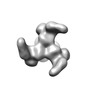
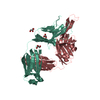
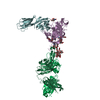
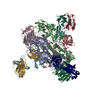
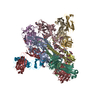

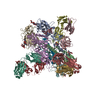
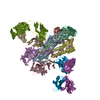
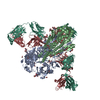
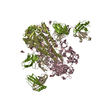
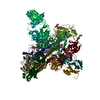
 Z (Sec.)
Z (Sec.) Y (Row.)
Y (Row.) X (Col.)
X (Col.)





















